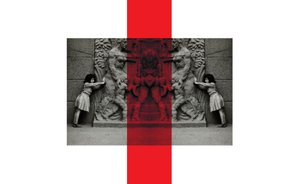Gülsün Karamustafa | The Monument and the Child
Opening hours: Tue-Sun 10 am - 6 pm, free entry
Special opening hours in the context of the "Opening Days" on 21st and 22nd of January 2011: 10.00 a.m. - 8.00 p.m.
Press talk : 19.01.2011, 10.00 a.m.
Opening: 20.01.2011, 7.00 p.m.
Welcome address and introduction: Andreas Spiegl, Vice-Rector for Teaching and Research at the Academy of Fine Arts Vienna,
H.E. Simon Smith, British ambassador, David Codling, project leader of "My City"
The artist is present.
My City is designed and implemented by the British Council in cooperation with Anadolu Kültür, Platform Garantie Contemporary Art Center and a number of partners in Turkey and Europe with the financial assistance of the European Union ((EU-Turkey Civil Society Dialogue: Cultural Bridges)
Commissioning new works by prominent artists from Europe, “My City” has explored art and public space in five cities across Turkey. The cities are Canakkale, Istanbul, Konya, Mardin and Trabzon.
In addition, artists from Turkey were hosted by leading residency programmes in Berlin, Dortmund, Helsinki, London, Vienna and Warsaw. The Academy of Fine Arts Vienna was able to invite the Istanbul-based artist Gülsün Karamustafa thanks to the British Council project “My City” supporting the dialogue between institutions and artists in the European Union and Turkey.
Taking up the historical relations between Vienna and Turkey, Karamustafa relies on an autobiographical element: two photographs taken by her father show Gülsün Karamustafa as a girl in front of a monumental sculpture in Ankara which was part of a plan for the square by Clemens Holzmeister and executed by Anton Hanak. Holzmeister and Hanak, both professors at Vienna’s Academy, underscored the close political and cultural connections between the two countries with their works. Karamustafa, who now draws on this constellation of autobiographical, political, cultural, and artistic traces in the context of the Academy, develops a three-dimensional and thematic narrative exploring the dialogues between the countries, the cities, and the representations of private and public spheres. The political character of her work lies in the fact that its subtext outlines a pattern of these spheres’ connections and connectedness which is based on the insight that we have to abandon the idea of separate cultural and political terrains and territories.
The statement that Gülsün Karamustafa, born in 1946, lives and works in Istanbul is not just to be read as a geographical note. Her life in Istanbul has made her a witness of the various political, cultural and social shifts which the city has seen since the 1950s. These changes not only include the growth of the city into the only megalopolis of Europe with more than 15 million inhabitants, but also all the phenomena associated with it from suburbanization and migration to the effects of economic conflicts. These changes also comprise the transformation of the remains of the erstwhile city of Constantinople as a point of intersection of various religions and cultures into an area that has been subject to Turkey’s modernization under Atatürk. Seen against the background of the political and ideological clashes between democratic forces, the military, the government, minorities, and fundamentalist movements, the place where Karamustafa lives and works presents itself as a highly complex challenge for an artistic practice engaging in social, political and cultural processes. Because of her commitment, the artist has come into conflict with the state machinery in a way that deprived her of her passport and thus of all possibility of travelling abroad from the 1970s to the mid-1980s. More or less condemned to not being able to leave her country, Karamustafa focused on the said shifts’ effects and phenomena in the mirror of Istanbul’s everyday culture: on the consequences and forms of migration, the role of women and their emancipatory practices and forms of resistance, on the ways of dealing with a potentially explosive cultural heritage, etc.
These themes run all the way through Gülsün Karamustafa’s work. Her methods are naturally based on research and interviews as well as on the attempt to isolate the details as symptoms or to interweave them in view of the coherence of certain issues. Thus, Karamustafa uncompromisingly confronts us with an artistic practice which can only be characterized regarding its range: it spans from photography and installation to video and film. Though the formal manifestations of her work may be quite different from each other, they all share the combination of documentary and fictitious, frequently ironic, perspectives. This blend comprises an interventionist pattern – an insistence on the possibility of interfering in what can be observed and ascertained.
Gülsün Karamustafa
Born in Ankara, Turkey in 1946, Gülsün Karamustafa studied at the State Academy of Art in Istanbul. Her installations and films investigate historical and social contexts. She explores issues of migration, the role of women in Turkish society, sociopolitical developments and phenomena, and the nature of identity as informed by ideological and psychological processes. She participated in the 2nd, 3rd, and 4th Istanbul Biennials of 1987, 1992, and 1995, in the 3rd Kwangju Biennial of 2000, in the 8th Havana and the 3rd Cetinje Biennials of 2003, the 1st Sevilla Biennial of 2004, and the 2nd Guangshou Triennial and the 11th Cairo Biennial of 2008. Her most recent solo presentations include shows at the Kunstmuseum Bonn and the Salzburger Kunstverein in 2008, as well as at the ifa Gallery in Stuttgart in 2011.
(Text: Andreas Spiegl)
Translation: Wolfgang Astelbauer
List of entries
-
Gülsün Karamustafa | The Monument and the Child
Opening hours: Tue-Sun 10 am - 6 pm, free entry
Special opening hours in the context of the "Opening Days" on 21st and 22nd of January 2011: 10.00 a.m. - 8.00 p.m.Opening
Main Building/ xhibit
Academy






